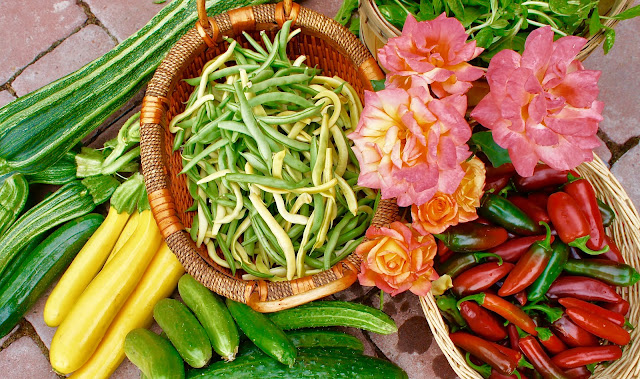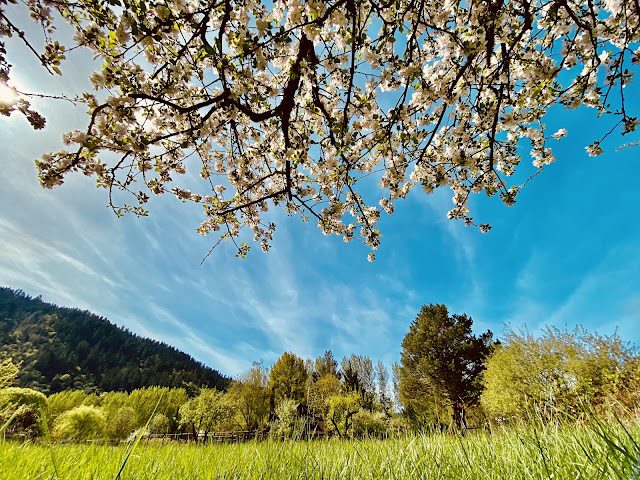 |
| Home and garden in July 2012. We've painted the house since then and stricken down the aggressive hop plant in the middle, but we expect our pandemic garden to look something like this. |
We may be headed in that direction now. We're not among the "survivalists" who migrated to Southern Oregon in the 1970s about the same time we did. The survivalists believed Southern Oregon was the safest place to escape radiation fallout should a nuclear war break out.
Us? We landed in this spot serendipitously. No plan. No destination. Blown by the wind. But damn. When we hit the land it hooked us. Well, the land and having a baby.
Remember those days? Hippies, including us, and many others, migrated to the rural West, sparking cultural clashes but ultimately melding with the locals to cultivate new lives in the new-to-us territory.
Now that a pandemic is poisoning the planet and rural lifestyles including small towns, farms and ranches, open spaces and wilderness all around must be looking pretty dang fine to people stuck in cities. If unemployed and anxious urban dwellers could swing it, my guess is that many would choose to relocate to where social distancing comes with the territory and a well-established gardening culture is in place.
 |
| Our neighborhood a mile outside the town of Rogue River shot from a mountain trail on the other side of the actual Rogue River. Our 3.5 acres is there someplace on the right. |
We can't know for sure what'll happen next. But gardening benefits include that you can pretty much predict your food future and also your health, provided you eat fresh whatever you can, and preserve the rest. (We give away a lot of produce.)
 |
| A late summer harvest but where are the tomatoes? |
 |
| Yes. Rainbows over our garden. |
Back to the land. Although I paint a rosy picture, usually, it is sad but true that PK and I have had an on/off-love/hate relationship with gardening for decades. Seeding, weeding, shoveling, spading, tilling, planting, fertilizing, watering, harvesting, and food preservation required by the big beautiful time-sucking rectangle in our backyard has been as much of a chore as it has been a cause for celebration.
And that's not even taking into consideration that when we bought the property, it was an orchard with 300+ apple trees! Now that was work! Most of which PK took on.
Instead, we decided to elongate the run of travel we've relished during the past decade. We'd been plotting a cross-country road trip in our sweet and spiffy Sprinter van. We'd roughed out a 3-4-month ramble that included music festivals, visits with family in Minnesota and New Jersey, a jaunt up to Newfoundland, and, as a grand finale, a flight across the pond for a European fall bicycle trip.
Of course, this trip is not going to happen. For sure not the flying-to-Europe part. I risk embarrassing myself even mentioning how the pandemic has upset our privileged lives of travel when so many are losing so much. We are fortunate and grateful to have choices.
We've chosen to switch gears. There's no ambivalence. Staying home is good, even if it's forced. Gardening is great, something that feels right and full of purpose. We never lack things to do. Days fly by. It's a privilege to have fertile land that we've worked through the decades, that rewards us with beauty and bounty, birds, and bees. Benevolence.
 |
| Cosmos volunteers return every year. Bees love them. Me too. |
Can it be that I am finally rooted? I guess so.
Addendum
Oddly enough, I was primed for pandemic gardening during an intense volunteer trip to Guatemala in February. There I was inspired, even moved, by the extensive organic gardening, and other tasks, accomplished by indigenous Guatemalans, many of them teenagers at a remote mountaintop school named Maya Jaguar.* A post about my time there is in the works.
 |
| A master gardener, Pascual, oversees the school's organic gardening programs. |
*The school is one of several efforts by the nonprofit Adopt-A-Village in Guatemala to lift Mayan youth from poverty and malnutrition through life-changing education. Graduates earn three certificates, one for completing academic studies, another for computer science proficiency, and a third for demonstrating competence at all phases of organic gardening. I love what I saw there.
PREVIOUS GARDENING POSTS
A new take on marinara plus gardening ambivalence
Mid-June garden is messy but good!















